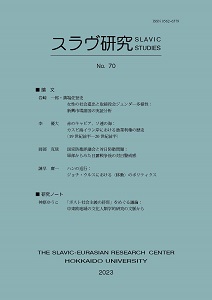赤のキャビア、ソ連の海―カスピ海イラン岸における漁業利権の歴史(19 世紀前半―20 世紀前半)
Red Caviar, Soviet Sea: History of the Fishery Concession on the Iranian Coast of the Caspian Sea (Early 19th – Early 20th Century)
Author(s): Yudai RiSubject(s): Diplomatic history, Political history, Government/Political systems, International relations/trade, 19th Century, Pre-WW I & WW I (1900 -1919), Geopolitics
Published by: Slavic Research Center
Keywords: Russian-Iranian relations; Soviet era; Caspian Sea; fishery agreement; national interests;
Summary/Abstract: In the history of Russian-Iranian relations, what historical continuity or rupture is observed between the Russian imperial period and the Soviet era? The answer to this research question can be found by examining how the early Soviet regime attempted to deal with the concessions that subjects of Imperial Russia had obtained in Iran. This article focuses on the fishery concession on the Iranian shore of the Caspian Sea (the Lianozov concession) and examines what significance the Soviet regime attached to the Lianozov concession and to the Caspian Sea itself, where the fishing grounds were located. In the nineteenth century, following its defeat in the wars with Russia and Britain, Iran was politically and economically subordinated to both countries. This subordination resulted in the transfer of ownership of various concessions by the Iranian government to the two powers and their subjects. Among these, of particular importance was the fishery concession that had been granted to Stepan Martinovich Lianozov, a subject of Imperia Russia. Previous studies on the relations of the early Soviet regime with Iran have the weakness of not bridging the imperial and Soviet periods. Volkov’s work examining the influence of Russian orientalists on Russia’s diplomacy towards Iran and the interaction between orientalists and the government is an exception, but apart from his groundbreaking work, almost no individual studies cover both periods. This trend also applies to studies that make more or less reference to the Lianozov concession. These studies do not treat the Lianozov concession as a major theme or analyze it diachronically, but only present fragments of its history. In order to overcome the limitations of these previous studies, this paper covers the period from early 19th century to early 20th century and examines how the Soviet regime dealt with a legacy of Imperial Russia—the Lianozov concession—considering the actions of the Iranian government as well. Thereby, it will answer the question of what historical constancy or discontinuity can be seen between Imperial Russia and the Soviet Union in the history of Russo-Iranian relations. This paper uses Russian archival sources and supplementarily Persian primary sources. To begin with, this paper touches on how merchants of Astrakhan embarked on the fishing industry on the Iranian coast of the Caspian Sea, in which the Lianozov family had achieved entrepreneurial success. Lianozov, after the outbreak of the Russian Revolution, faced a financial predicament, which led to conflicts over the ownership of fishing rights. This paper then carefully traces the process of diplomatic negotiations over the fishery agreement between the Soviet regime and the Iranian government after the conclusion of the Soviet-Iranian Treaty of Friendship in 1921. By examining the historical trajectory, this study shows that the Soviet regime was initially interested in using the fishery concession under the control of the People’s Commissariat for Food to seek a solution to famine in Russia, and that once the Soviet regime alleviated the food crisis to some extent, the People’s Commissariat for Foreign Trade and the People’s Commissariat for Workers’ and Peasants’ Inspection departed from their original purpose and began to specialize in caviar production to gain foreign currency, just as Lianozov had done. This paper also shows that the Soviet government’s policy regarding fishery concession on the southern coast of the Caspian Sea was not necessarily monolithic because the People’s Commissariat for Foreign Affairs objected to the way in which the business enterprise was operated wholly in favor of the Soviet side. However, this interdepartmental conflict of opinions notwithstanding, no department in the Soviet government put forward the policy of abandoning the fishery concession itself for Iran’s national interests. This was due to the fact that the Soviet government was cautious about the security environment of the Caspian Sea, particularly with Britain in mind. Many policymakers in the Soviet regime, either intentionally or unintentionally, recognized that the entire Caspian Sea region should still be retained as a Soviet sea. This analysis reveals a historical continuity between the imperial and Soviet periods. Moreover, in terms of security, the Lianozov concession can be examined in analogy with the Chinese Eastern Railway concession, which was a pending issue in Sino-Soviet relations in Northeast Asia in the 1920s. This consideration implies the possibility of examining the Soviet foreign policy on a Eurasian scale through a comparative analysis of the history of the Lianozov concession.
Journal: Slavic Studies
- Issue Year: 2023
- Issue No: 70
- Page Range: 37-71
- Page Count: 35
- Language: Japanese

